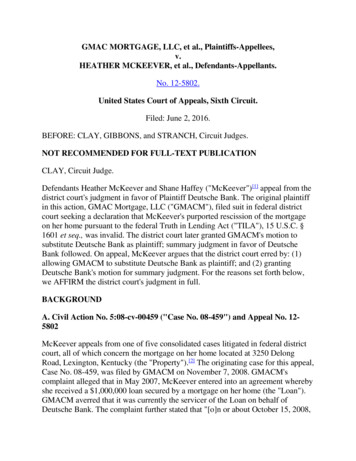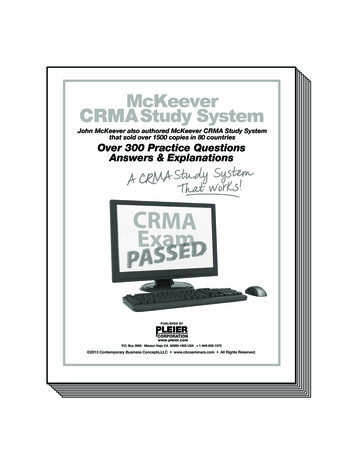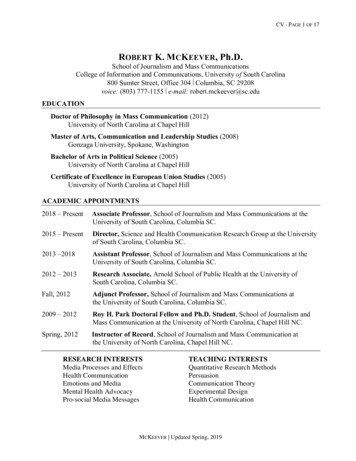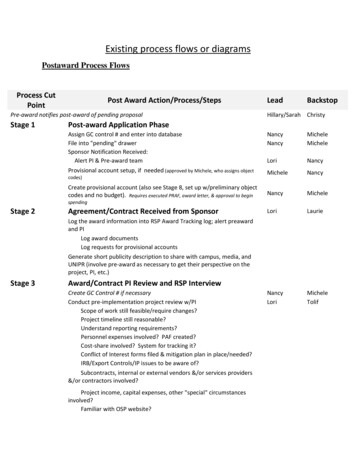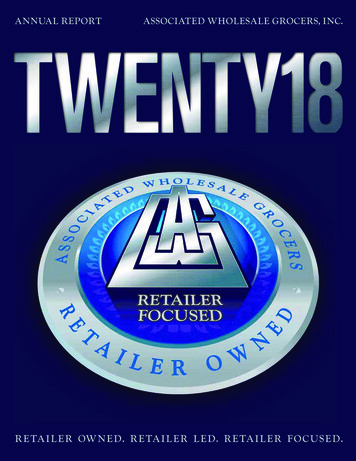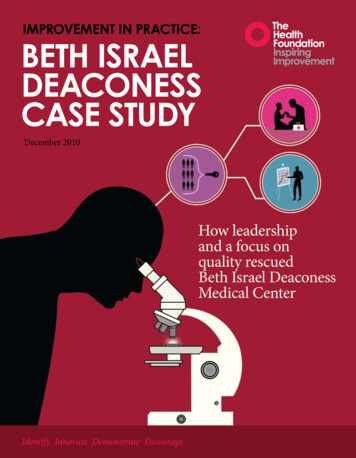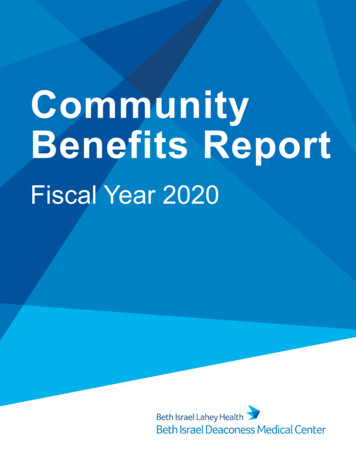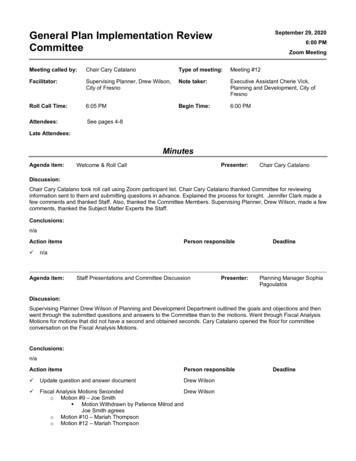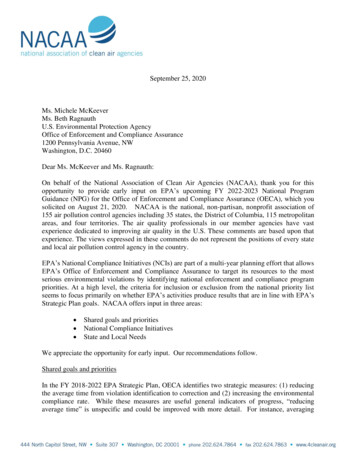
Transcription
September 25, 2020Ms. Michele McKeeverMs. Beth RagnauthU.S. Environmental Protection AgencyOffice of Enforcement and Compliance Assurance1200 Pennsylvania Avenue, NWWashington, D.C. 20460Dear Ms. McKeever and Ms. Ragnauth:On behalf of the National Association of Clean Air Agencies (NACAA), thank you for thisopportunity to provide early input on EPA’s upcoming FY 2022-2023 National ProgramGuidance (NPG) for the Office of Enforcement and Compliance Assurance (OECA), which yousolicited on August 21, 2020. NACAA is the national, non-partisan, nonprofit association of155 air pollution control agencies including 35 states, the District of Columbia, 115 metropolitanareas, and four territories. The air quality professionals in our member agencies have vastexperience dedicated to improving air quality in the U.S. These comments are based upon thatexperience. The views expressed in these comments do not represent the positions of every stateand local air pollution control agency in the country.EPA’s National Compliance Initiatives (NCIs) are part of a multi-year planning effort that allowsEPA’s Office of Enforcement and Compliance Assurance to target its resources to the mostserious environmental violations by identifying national enforcement and compliance programpriorities. At a high level, the criteria for inclusion or exclusion from the national priority listseems to focus primarily on whether EPA’s activities produce results that are in line with EPA’sStrategic Plan goals. NACAA offers input in three areas: Shared goals and prioritiesNational Compliance InitiativesState and Local NeedsWe appreciate the opportunity for early input. Our recommendations follow.Shared goals and prioritiesIn the FY 2018-2022 EPA Strategic Plan, OECA identifies two strategic measures: (1) reducingthe average time from violation identification to correction and (2) increasing the environmentalcompliance rate. While these measures are useful general indicators of progress, “reducingaverage time” is unspecific and could be improved with more detail. For instance, averaging
2times may be markedly different for states and locals that must follow timelines according tostate and local enforcement rules and regulations. EPA should also be cautious in how itmeasures success based on increasing the compliance rate: real world environmental outcomesalso matter and improving compliance rates should not come simply from reduced enforcementor monitoring. Finally, EPA should consider whether enforcement actions provide equitableprotections for minority, disadvantaged, or vulnerable communities, and establish performancemeasures to evaluate improvement in this area.National Compliance InitiativesEPA has established six National Compliance Initiatives (NCIs), including: Creating Cleaner Air for Communities by Reducing Excess Emissions of HarmfulPollutantsStopping Aftermarket Defeat Devices for Vehicles and EnginesReducing Hazardous Air Emissions from Hazardous Waste FacilitiesReducing Risks of Accidental Releases at Industrial and Chemical FacilitiesReducing Significant Non-compliance with National Pollutant Discharge EliminationSystem (NPDES) PermitsReducing Non-compliance with Drinking Water Standards at Community Water SystemsAs a broad rule, EPA priorities should focus on where the agency can do work that its state andlocal partners cannot, such as in areas where they do not have jurisdiction or authority (e.g., riskmanagement plan oversight). Moreover, EPA plays an essential role in addressing sources thatare nationally significant, such as those that represent a substantial portion of the emissionsinventory, can be cost-effectively regulated at the national level and offer the potential to reduceemissions of numerous pollutants and precursors that cause or contribute to elevated criteriapollutant levels and numerous other public health and environmental problems. As EPAdetermines its 2022-2023 priorities, it should focus its attention on situations where state andlocal agencies are not the appropriate entities or lack the national-scale resources to be effective,especially for issues that are nationally significant rather than regional.With regard to the specific list of current NCIs, NACAA supports their continuation, particularlythe Aftermarket Defeat Devices NCI. EPA should expand this NCI to address broader mobilesource issues. A mobile source NCI could focus on continuing the agency’s efforts assuringcompliance with mobile source emission standards and fuel standards. This could includeproactive investigation of all models of diesel engines to see if strategies to avoid pollutioncontrols have been used, uncertified parts or engines or engines have been sold, or defeat deviceshave been installed, among other violations. As a compliance priority, EPA could go beyond onroad motor vehicles to ensure compliance by nonroad vehicles and engines, such as constructionand farm equipment and marine vessels. The latter could include enforcement of the EmissionsControl Area around the United States coast, which impacts states as far away as the Midwest.Finally, a mobile source NCI could examine excessive rail idling, which not only wastes fuel andcauses odors, but also causes emissions of diesel particulate and ozone precursors. Dieselemissions are directly harmful to human health by exposing surrounding communities to cancer
3risks, and these emissions exacerbate ozone problems, especially in “extreme” and “severe”areas where every feasible reduction is needed.NACAA also strongly supports the continuation of the NCI “Creating Cleaner Air forCommunities by Reducing Excess Emissions of Harmful Pollutants.” This is an area wherecontinued partnership between the federal government and the state and local air pollutioncontrol agencies has yielded cleaner air and public health protection for Americans. However, asit proceeds, EPA should lay out clear metrics for continued performance that build on theimprovements made for health outcomes, particularly addressing the most vulnerablecommunities. Lastly, it is unclear as to why this NCI refers to “excess” emissions. To clear upany potential confusion, this initiative should be edited to read, “Creating Cleaner Air forCommunities by Reducing Emissions of Harmful Pollutants”.In keeping with the Agency’s commitments to advancing environmental justice, EPA shouldadopt an additional NCI focused on improving enforcement that protects communitiesdisproportionately bearing the impacts of pollution. The past year has highlighted the degree towhich systems that are operated by officials with good intentions to deliver equitable protectioncontinue to produce outcomes that unequally affect black people, indigenous people, and peopleof color, as well as those in poor communities. EPA’s enforcement and compliance assistanceprograms should be evaluated to see if their outcomes provide equitable protection, or ifembedded in their systemic design or implementation they deliver outcomes that afford lessprotection to communities that face other disadvantages. Further, many enforcement activitiesmay be triggered and driven by community complaints. Significant violations may persist indisenfranchised communities that may be reluctant to file complaints. Beyond examiningimpacts, proactively targeting inspection and enforcement to overburdened communities mayhelp to address this disparity. This NCI would not only allow EPA to address potential systemicdeficits that pose an obstacle to its realizing its environmental justice goals, it would also supplymuch-needed aid to communities that early research indicates may be at greater risk of sufferinghigher mortality from the COVID-19 pandemic1. Although screening with EJSCREEN ismentioned in the previous 2020-2022 program guidance, it seems appropriate for EPA to investin resources that improve its actions to protect communities that continue to bear the heaviestburdens of pollution.EPA should also add a new NCI focused on wood-heater compliance, especially given the recentamendments to the 2015 New Source Performance Standards (NSPS) for New Residential WoodHeaters, New Hydronic Heaters and Forced-Air Furnaces2 and the May 22, 2020 proposed sellthrough for noncompliant devices3. Residential wood heating in the U.S. produces five timesmore direct fine particulate matter (PM2.5) emissions than all U.S petroleum refineries, cementmanufacturers and pulp and paper plants combined.4 Woodsmoke contains a mixture of ewsource-performance3 pdf/2020-11096.pdf4 Introduction to Hearth Appliances, Nature and Magnitude of Residential Wood Smoke, Presentation ofLarry Brockman, U.S. Environmental Protection Agency (March 6, 2018) cuments/RWH-Intro to Hearth AppliancesLarry Brockman EPA-030618.pdf2
4substances that penetrate deep into the lungs. PM2.5 from woodsmoke not only affects air qualityin entire regions, but also significantly impacts air quality and public health at the local level,including in communities and neighborhoods located in valleys where woodsmoke accumulates.In fact, a single wood-burning device can emit enough pollutants to place an entire neighborhoodat risk.5 Each year, residential wood combustion is responsible for hundreds of thousands of tonsof PM2.5 emissions. These emissions can increase the concentration of particle pollution tolevels that cause serious health impacts ranging from exacerbation of cardiac and respiratoryproblems to premature death.6 Further, PM2.5 contributes significantly to our nation’s regionalhaze problem. Residential woodsmoke also contains volatile organic compounds and carbonmonoxide, as well as toxic air pollutants such as benzene, toluene, aldehyde gases, polycyclicorganic matter (POM), black carbon and methane. EPA estimates that residential woodcombustion contributes 44 percent of all anthropogenic POM emissions and accounts for 50percent of all area source cancer risks and 8 percent of all noncancer respiratory effects.7 An NCIfocused on these sources would enable EPA to lead effective restrictions on the sale of noncompliant units with potential health benefits exceeding those from the 2015-2019 actions takenagainst auto manufacturers that used defeat devices to bypass pollution regulations.State and Local Partner NeedsAs EPA’s co-regulators, we believe it is essential that state and local air quality agencies andEPA work cooperatively on enforcement and compliance activities. Indeed, EPA has indicatedthat it plans to enhance its reliance on state and local air quality programs through cooperativefederalism. Therefore, it is more critical than ever that state and local air quality agenciesreceive adequate federal funding to be able to carry out this important work. The level of federalsupport to state and local agencies that are implementing federal programs, policies andstandards should reflect the scope and complexity of the responsibilities that these agencies areundertaking. Unfortunately, federal funding to state and local air agencies has not beenadequate; in fact it has not even kept pace with inflation. In order to continue to carry out ourresponsibilities and perhaps take on additional work under cooperative federalism, significantincreases in federal grants are required. We believe the investment of federal funds in state andlocal agency activities enables us to be effective in work of vital importance to this country.To the extent possible, EPA should treat states in a consistent manner. While some flexibility iscalled for to reflect different circumstances, as a general matter it makes sense to strive fornational consistency. This is especially true when addressing issues with larger companies thathave a presence in multiple jurisdictions. In order to move toward greater consistency,headquarters should work closely with regional offices to implement new guidance.It is very important that, when requested, EPA provide an environmental presence to aid stateand local agencies in enforcement activities. Even in state or local areas that are authorized toenforce clean air requirements, EPA serves a critical role in addressing serious nationalnoncompliance problems, such as those affecting multiple jurisdictions. EPA should also assist5Source: Bay Area Air Quality Management DistrictStrategies for Reducing Residential Wood Smoke, U.S. Environmental Protection Agency (March 2013),p. 4 – ts/strategies.pdf7 Supra note 36
5state and local agencies with enforcement issues when the agencies request support due to a lackof resources or capability. Joint enforcement action may, at times, be the best option when EPAand the appropriate agency are in agreement.Provided an NCI is added to focus resources on environmental justice, training on theenforcement implications of environmental justice would be critical to the success of such anendeavor. In addition, training associated with all of the NCIs would help to ensure consistentapplication of resource and priorities across all regions.In all programs undertaken, funding must be adequate both for state and local agencies, and forour federal partners as well. EPA must invest in its own workforce. EPA staffing levels are wellbelow their historical levels and are currently at their lowest levels since 1987. Anecdotally, ouragencies have noted they have seen indications that travel funding and approval is a barrier toprioritizing enforcement actions by the agency. EPA must include travel funding for its owninspectors and other staff in order to remain an effective partner. Some state and local agenciesnote that digital incompatibility remains a barrier to effective joint enforcement. Investments ininformation systems that align EPA’s systems with those of its state and local regulatory partnerswould improve information sharing and management and reduce the burdens on agencies alreadystretched by resource constraints.We thank you for this opportunity to provide early input into the development of the NPG for FY2022-23 and we look forward to continuing to work with EPA as the agency develops the finaldocument.Sincerely,Michael G. DowdVirginiaCo-ChairNACAA Enforcement CommitteeRichard A. StedmanMonterey, CaliforniaCo-ChairNACAA Enforcement Committee
Dear Ms. McKeever and Ms. Ragnauth: On behalf of the National Association of Clean Air Agencies (NACAA), thank you for this opportunity to provide early input on EPA's upcoming FY 2022-2023 National Program Guidance (NPG) for the Office of Enforcement and Compliance Assurance (OECA), which you
